Northern Channel Islands Information for Anacapa, Santa Cruz, Santa Rosa, and San Miguel Islands
The Northern Channel Islands are very diverse and large and because of this, we have made two separate pages covering the islands. This one has the four Northern Channel Islands and the other page has the four Southern Islands. We have not only covered some of the history and details of each island but we have also listed many of the dive sites and info about scuba diving the islands. Some of the dive sites you will find on maps and others you won’t. Over the years, Ken the owner of Channel Islands Dive Adventures has dived all these sites.
We hope you enjoy all the information listed here and come back to read a little each time. There is just way too much to check out at one time.
Anacapa Island
Santa Cruz Island
Santa Rosa Island
San Miguel Island
Anacapa Island
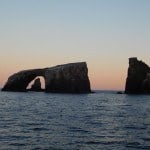 Anacapa lies 11 miles southwest of Oxnard and 14 miles off the coast from Ventura. Almost five miles long, its total land area is about one square mile. It is composed of three small islets. They are West, Middle, and East Anacapa Island. For much of the year, the island vegetation looks brown.
Anacapa lies 11 miles southwest of Oxnard and 14 miles off the coast from Ventura. Almost five miles long, its total land area is about one square mile. It is composed of three small islets. They are West, Middle, and East Anacapa Island. For much of the year, the island vegetation looks brown.
 With winter rains, Anacapa takes on a new life full of color with the blooming Coreopsis. Sea mammals are often seen around Anacapa shores. Ocean waves have eroded the perimeter of the island, creating steep cliffs towering hundreds of feet in height. At the east end of Anacapa, a natural bridge has formed in the ocean. Forty-foot high Arch Rock is a trademark of Anacapa and Channel Islands National Park.
With winter rains, Anacapa takes on a new life full of color with the blooming Coreopsis. Sea mammals are often seen around Anacapa shores. Ocean waves have eroded the perimeter of the island, creating steep cliffs towering hundreds of feet in height. At the east end of Anacapa, a natural bridge has formed in the ocean. Forty-foot high Arch Rock is a trademark of Anacapa and Channel Islands National Park.
Diving Anacapa
Scuba diving at Anacapa Island can be an easy and fulfilling trip for everyone, with its many excellent dive spots and good visibility, you will be in for a treat. Most dives are next  to the island in depths from a few feet to about 60 feet. It is possible to do deeper dives but this is really not required to see more. The bottom is rocky reef and sand in most places. Some spots offer kelp forests, walls, and pinnacles. Hundreds of plants and small animals share the reefs with many varieties of fish including kelp bass, sheepshead, and garibaldi.
to the island in depths from a few feet to about 60 feet. It is possible to do deeper dives but this is really not required to see more. The bottom is rocky reef and sand in most places. Some spots offer kelp forests, walls, and pinnacles. Hundreds of plants and small animals share the reefs with many varieties of fish including kelp bass, sheepshead, and garibaldi.
Anacapa Island has some exhilarating diving on some outer deeper reefs and pinnacles. Most are seldom dived and can be good for hunting, photography, or sightseeing, and sometimes the giant black sea bass will pay you a visit.
Most boats seem to forget about some of these sites because they are out away from the island where currents can sometimes be an issue but on the good day when you can dive the outer reefs & pinnacles, you will be glad you did. These are advanced dive sites with depths ranging from 50’-120’, visibility of 20’-80’, and possible currents.
Best Time for Diving
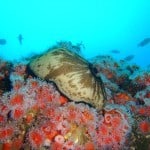 Diving can be done all year but the best time is from late summer to late winter. Water temperature is coldest from February to May varying between 52° and 58°. From June to September it will range from 60° to as high as 70° then slowly begin to drop. October through January finds the water in the low sixties to high fifties. Visibility rarely goes below 10 feet and can be as high as 100 feet with an average of 40 feet on most days.
Diving can be done all year but the best time is from late summer to late winter. Water temperature is coldest from February to May varying between 52° and 58°. From June to September it will range from 60° to as high as 70° then slowly begin to drop. October through January finds the water in the low sixties to high fifties. Visibility rarely goes below 10 feet and can be as high as 100 feet with an average of 40 feet on most days.
What to Expect
 It is not unusual to spot sea lions, seals, lobster, bat rays, horn sharks, moray eels, and occasionally giant black sea bass. Look up and you could see blacksmith perch, sardines, mackerel, anchovies, and other small schooling fish. The more you look the more you see! For someone who has never dived in a kelp forest, this can be quite spectacular. It gives you a sense of being in an underwater forest. The sun rays shining through the kelp combined with curious sea lions darting about can make for some breathtaking moments.
It is not unusual to spot sea lions, seals, lobster, bat rays, horn sharks, moray eels, and occasionally giant black sea bass. Look up and you could see blacksmith perch, sardines, mackerel, anchovies, and other small schooling fish. The more you look the more you see! For someone who has never dived in a kelp forest, this can be quite spectacular. It gives you a sense of being in an underwater forest. The sun rays shining through the kelp combined with curious sea lions darting about can make for some breathtaking moments.
 When diving Anacapa there are some areas you must pay special attention to. The north side of West Anacapa is protected by both a State and Federal Marine Conservation area (SMCA & FMCA). The north side of both Middle and East Anacapa are protected by a State and Federal Marine Reserve (SMR & FMR). Then there is also the Brown Pelican fledging area that is located around the north-east end of West Anacapa. This area is closed to all boat traffic from January 1 to October 31 out to depths of 120 feet.
When diving Anacapa there are some areas you must pay special attention to. The north side of West Anacapa is protected by both a State and Federal Marine Conservation area (SMCA & FMCA). The north side of both Middle and East Anacapa are protected by a State and Federal Marine Reserve (SMR & FMR). Then there is also the Brown Pelican fledging area that is located around the north-east end of West Anacapa. This area is closed to all boat traffic from January 1 to October 31 out to depths of 120 feet.
 Anacapa is also home to a deep plane wreck and a shallow paddle wheeler wreck. Both wrecks are under the jurisdiction of the National Park Service. Collecting anything from either is strictly illegal. However, you can still visit the remains of both, you just can’t take souvenirs, only pictures
Anacapa is also home to a deep plane wreck and a shallow paddle wheeler wreck. Both wrecks are under the jurisdiction of the National Park Service. Collecting anything from either is strictly illegal. However, you can still visit the remains of both, you just can’t take souvenirs, only pictures
If you like Underwater Arches, there are three shallow ones at Anacapa Island that you can swim through and all can be fun and relaxing dives. All 3 sites are excellent for visits from the sea lions and harbor seals.
Because of the three islands that comprise Anacapa, we will cover it here in 2 sections. The first will be West Anacapa to East Anacapa, west end to Arch Rock and the second will be East Anacapa to West Anacapa, Arch Rock to West End Pinnacles.
There are many good dive sites around Anacapa with some of them listed below:
West Anacapa to East Anacapa-Northside (front side) west end to Arch Rock:
- Goldfish Bowl-This area is a favorite for classes and is in the Anacapa Island Marine Conservation Area (MCA). It is a rocky reef with large rocks, crevices, and some kelp. Some fish here but smaller and some invertebrate life. We only have this site listed here as it is very popular with newer divers. Depths are between 20’-60’.
- Portuguese Rock-Very rocky area up close to the island with a sandy bottom. Lots of large rocks with crevices, small caves, mini walls, healthy kelp, and more. Large sheepshead, lobsters, ocean whitefish, calicos, and kelp bass. Lots of invertebrates on the rocks and good for photography. This area is in the Anacapa Island Marine Conservation Area (MCA) and up against the eastern part of the Pelican Reserve. Depths from 15’-40’.
- Barracuda Rock-Barracuda Rock is on the north side, west end of West Anacapa. It is a large underwater arch with shallow reef ranging in depths of 15’-40’. This site is also in the Pelican Roosting area-This area is in the Anacapa Island Special Closure area and is completely closed from January 1 to October 31 out to depths of 120 feet. It is open to people and boats from November 1 to December 31. This area has some nice shallow rocky reef from about 10’-40’ with a steep slope going deeper made up of sand and rocky outcroppings. This site has a variety of things to offer like the very friendly sheepshead, lobsters and halibut. Depths are between 15’-120’
- Guano Banks- Nice outer rocky reef a short distance offshore. Lots of rock structures with crevices and healthy kelp. Large sheepshead, lobsters, calicos, rockfish, and kelp bass. Lots of invertebrates on the rocks and good for photography. This area is up against the eastern part of the Pelican Reserve. Depths from 15’-60’.
- Winfield Scott-The Winfield Scott was a 225-foot-long, side-wheel passenger steamer that ran aground on the north side of the east end of Middle Anacapa in December of 1853. There were over 400 passengers and with no loss of life everyone was rescued but the Winfield Scott did not fare well with the rocks of Anacapa. There were attempts to salvage her with limited success. You can still see some of the wreck which is mainly the paddlewheel and a shaft but that can even be hard to distinguish with all the growth on them. This is an easy shallow dive ranging from 10’-30’ with some fish, kelp, and possible sightings of black sea bass.
- TBM Avenger Plane Wreck-The Avenger is a WWII Navy torpedo bomber that was on a training mission in the early ’50s along with 4 other planes. It hit another plane in the formation and they both crashed. The one that is diveable went down on the north side of east Anacapa and had no loss of life. The other plane went down on the backside of Anacapa with loss of life and has never been found. The TBM sits in about 120’ in the sand about 40’ from a nice reef and can have visibility of 20’-60’. After all the years you can still tell it’s a plane although it is deteriorating rather quickly. It has attracted fish around it and is an excellent deep dive.
- Quarter Acres-Quarter Acres is a large area on the north side of Middle and East Anacapa Islands. This is all advanced diving due to depths and currents ranging between 80’-120’. The reef is rocky with some sand and lots of structure. Here can be good for lobster diving with all the rock reef, outcroppings, and ledges. You will also see sheepshead, rockfish, lingcod, gorgonians, and more.
- Cathedral Cove-Cathedral Cove is a site good for all level divers and is on the north side of East Anacapa. It is in one of the islands Marine Reserves and with depths of 20’-40’, good reef structure, lots of fish, gorgonians, nudibranchs, possible black sea bass sightings, and kelp makes this a spot for some excellent diving.
- Landing Cove-Landing Cove is on the north side, east end of East Anacapa. It is in the Anacapa Island Marine Reserve (MR) and has lots of kelp, big fish, lobster, sea lions harbor seals, calico, sheepshead, and sometimes giant black sea bass along with lots of gorgonians on the rocks. This area has a short double reef and the main point of interest here is the large underwater arch that you can swim through on the outer part of the reef. This area looks like the islands did way back when. Along either side where the island drops into the sea is a sloped wall leading to a sandy bottom. The depths here range from 30’-50’. Word of caution for this site-boats drop off and pick up people visiting the island in the cove at the big cement structure close to the water’s edge so DO NOT get close or it could be your last dive!
East Anacapa to West Anacapa, Arch Rock to West End Pinnacles:
- Underwater arch-Underwater Arch is on the south side of East Anacapa. This is a nice shallow reef ranging from 20’-40’ and the attraction here is the sea lions.
- East Fish Camp-Good anchorage and shallow dive. Some large rock piles with kelp and sand between rock areas. The shallow area has lots of smaller rock and eelgrass. Depths are between 10’-40’.
- Aquarium-Aquarium actually covers a large area on the south side of West Anacapa where you could make several dives and see something different every time. The depths here range from around 40’-60’ and deeper to 90’. The main area is a rocky reef with lots of structure and a wall dropping to a sandy bottom and sometimes currents on the outer edge. Lots of kelp here, rockfish, nudibranchs, gorgonians, sheepshead, calico, and possible black sea bass sightings.
- Cat Rock-Cat Rock is on the south side of the West Anacapa and is close to the middle of the island. It is a large prominent rock that is located close to the edge of the island. The area around it forms a small bay or harbor where you can dive getting protection from the currents just outside the outer area. The depths here can range from 20’ to 60’ with lots of rocky structure and some sand channels running through the reef. There is usually some kelp here with some schools of fish, gorgonians, lobsters, and lots of invertebrates covering the rocks closer to the outer area where the current can supply them dinner. This site can be good for all level divers.
- Underwater Island-Large rocky reef area that is more like a large mound, hence the name “Underwater Island”. Some boulders and large rocks with lots of big crevices. Some fish like sheepshead, rockfish, small lingcod, and lobsters. Sometimes the sea lions will visit you here and there is always a chance to see giant black sea bass in this area. Lots of invertebrate life with smaller strands of kelp growing from the upper part of the reef. Depths are between 30’-60’.
- Coral Reef-Coral reef is off the south side of West Anacapa and has some very good large reef structures. Depths here range from about 20’-50’ with a drop off that goes down to the sand at around 80’-90’. This site usually has kelp, sheepshead, calico, nudibranchs, possible black sea bass sightings, lobster, and more.
- Dicks Spot-Dicks Spot is a seldom dived pinnacle off the south side of West Anacapa. This is an advanced dive with currents and depths ranging from 65’-120’. This area is more like a large rocky reef with a pinnacle towards the top. There are lots of crevices and places to look for lobsters, lingcod, and rockfish. You will also see gorgonians, sheepshead, nudibranchs, and invertebrates.
- Rat Rock-Rat Rock is on the westerly tip of West Anacapa and is best for advanced divers due to the current that can sweep the area. Depths here are mainly from 20’-65’ but you can easily venture out deeper so be careful. This area is mainly all rocky reef with good structure and as you get deeper you will come to sand and rock rubble. Here you will find lots of life with gorgonians, fish, lobsters, and invertebrates due to the currents that sweep the area.
- West End Pinnacles-This area is an extension of the west end of Anacapa. It is a series of jagged rocky reef-forming smaller pinnacles with lots of large crevices and valleys. Current is usually a big issue here and drift diving this area is the only way with experienced boat owners and divers. This area is wild, rugged, and seldom gets visitors and is outside of the Anacapa Islands Maine Conservation Area (CMA). You will find Sheepshead, rockfish, lingcod, lobster, and more plus the rocks have much invertebrate life on them. Depths are between 30’-130’.
Santa Cruz Island
 Santa Cruz Island is the largest and most diverse of the islands within the Channel Islands National Park. Santa Cruz Island is about 24 miles long and is 19 miles from Ventura. Its land area is about 96 square miles. The central valley’s North Slope is a rugged ridge; the south slope is an older, more weathered ridge. At 2,470 feet, the highest of the Channel Islands Mountains is found here. Santa Cruz Island’s 77-mile varied coastline has steep
Santa Cruz Island is the largest and most diverse of the islands within the Channel Islands National Park. Santa Cruz Island is about 24 miles long and is 19 miles from Ventura. Its land area is about 96 square miles. The central valley’s North Slope is a rugged ridge; the south slope is an older, more weathered ridge. At 2,470 feet, the highest of the Channel Islands Mountains is found here. Santa Cruz Island’s 77-mile varied coastline has steep  cliffs, gigantic sea caves, coves, and sandy beaches.
cliffs, gigantic sea caves, coves, and sandy beaches.
 The shoreline cliffs, beaches, offshore rocks, and tide pools provide important breeding habitat for colonies of nesting sea birds, plants, and animals. To biologists, Santa Cruz is specifically significant for its diversity of habitat, greater than any other of the Channel Islands. In 1988 the Nature Conservancy acquired the western 90 percent of the island and the National Park Service owns the eastern 10%.
The shoreline cliffs, beaches, offshore rocks, and tide pools provide important breeding habitat for colonies of nesting sea birds, plants, and animals. To biologists, Santa Cruz is specifically significant for its diversity of habitat, greater than any other of the Channel Islands. In 1988 the Nature Conservancy acquired the western 90 percent of the island and the National Park Service owns the eastern 10%.
Diving Santa Cruz Island
 Scuba diving at Santa Cruz Island offers a bit milder diving conditions with its many dive sites it offers endless diving opportunities year-round. From sandy bays known for excellent halibut hunting to vast rocky reefs covered with kelp to mini walls covered with life, you can always find a fantastic dive spot.
Scuba diving at Santa Cruz Island offers a bit milder diving conditions with its many dive sites it offers endless diving opportunities year-round. From sandy bays known for excellent halibut hunting to vast rocky reefs covered with kelp to mini walls covered with life, you can always find a fantastic dive spot.
Santa Cruz sits in the transition zone of warm southerly and colder northerly currents, creating diverse underwater life and one of the few places you can find simian snails on the stalks of the red gorgonians. Unknown too many, this island is home to a very extensive system of underwater caves and caverns including Painted Cave which is the second-longest and one of the deepest sea caves in the world.
 The island is blessed with countless coves and anchorages offering protection from wind and weather. The weather usually blows out of the north and strikes the side of the island that faces the mainland. The open ocean side is often the lee side with the calmest conditions. Santa Cruz Island is also home to two wrecks, the Spirit of America shipwreck and a WWII Navy Grumman Guardian plane wreck.
The island is blessed with countless coves and anchorages offering protection from wind and weather. The weather usually blows out of the north and strikes the side of the island that faces the mainland. The open ocean side is often the lee side with the calmest conditions. Santa Cruz Island is also home to two wrecks, the Spirit of America shipwreck and a WWII Navy Grumman Guardian plane wreck.
Best Time for Diving
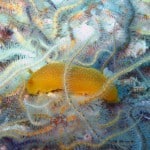 Diving can be done all year but the best time is from late summer to late winter. Santa Cruz Island is where you can find some of the most diverse water temperatures of any of the islands.
Diving can be done all year but the best time is from late summer to late winter. Santa Cruz Island is where you can find some of the most diverse water temperatures of any of the islands.
The east end tends to get the warmer southern temperatures and the west end gets the colder northern temperatures. Water temperature is coldest from February to May varying between 52° and 58°. From June to September it will range from 58° to as high as 65° then slowly begin to drop. October through January typically finds the water in the low sixties to high fifties. Visibility rarely goes below 10 feet and can be as high as 50 feet or better on a good day.
What to Expect
 The marine life surrounding Santa Cruz is a whole other world. Porpoises, dolphins, and whales can be sighted near island shores, feeding in the wealth of kelp forests. Pinnipeds such as harbor seals and California sea lions “haul out” in isolated coves to warm themselves and seek refuge. Ragged cliffs, offshore rocks, and tide pools support large colonies of breeding sea birds, shellfish, crustaceans, and other shoreline plants and animals.
The marine life surrounding Santa Cruz is a whole other world. Porpoises, dolphins, and whales can be sighted near island shores, feeding in the wealth of kelp forests. Pinnipeds such as harbor seals and California sea lions “haul out” in isolated coves to warm themselves and seek refuge. Ragged cliffs, offshore rocks, and tide pools support large colonies of breeding sea birds, shellfish, crustaceans, and other shoreline plants and animals.
 When diving Santa Cruz Island, there are three areas you must pay special attention to. On the Northeast end, you have the Scorpion Marine Reserve (MR), the Northwest end is the Painted Cave Marine Conservation area (MCA) and on the Southwest side you have the Gull Island State Marine Reserve (MR). Each has different rules and if you are planning any hunting always know what they are before entering these areas.
When diving Santa Cruz Island, there are three areas you must pay special attention to. On the Northeast end, you have the Scorpion Marine Reserve (MR), the Northwest end is the Painted Cave Marine Conservation area (MCA) and on the Southwest side you have the Gull Island State Marine Reserve (MR). Each has different rules and if you are planning any hunting always know what they are before entering these areas.
Because Santa Cruz is such a large island we will cover it in 4 main areas-East End, West End, Southside (backside), and the Northside (front side)
Southeast Santa Cruz Island-Yellowbanks to Willows Anchorage
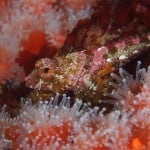 The backside of Santa Cruz is usually calm and sheltered from bad weather and full of excellent dive spots running all the way from Yellowbanks to the east end. Some of the sites are around the anchorages such as; Blue Banks, Alberts, and Willows. Some are up against the island with walls or steep slopes and others that are close to a point such as Bowen Point have rocky outcropping that extends out under the water. Most of these spots have healthy kelp forests that can be good for hunting, photography, or sightseeing. The depths range from 20’-80’ and visibility often runs from 20’-60’. If diving this area, beware of boaters and at times strong currents that will keep you from diving the outer areas.
The backside of Santa Cruz is usually calm and sheltered from bad weather and full of excellent dive spots running all the way from Yellowbanks to the east end. Some of the sites are around the anchorages such as; Blue Banks, Alberts, and Willows. Some are up against the island with walls or steep slopes and others that are close to a point such as Bowen Point have rocky outcropping that extends out under the water. Most of these spots have healthy kelp forests that can be good for hunting, photography, or sightseeing. The depths range from 20’-80’ and visibility often runs from 20’-60’. If diving this area, beware of boaters and at times strong currents that will keep you from diving the outer areas.
There are some good dive sites around this area with some of them listed below:
- Yellowbanks- This is a large extensive area on the southeast side of Santa Cruz past Smugglers Cove. Yellowbanks has large kelp beds and equally large reefs. The reefs are a variety of different types. Some are parallel reefs with sand between them, some are low lying rocky reefs and others are large rocky outcroppings with mini walls. With the entire area having a good reef structure, there is much to see such as fish, lobsters, lots of invertebrate life, and plenty of gorgonians. Depths can range from 40’-80’ and visibility can be 20’- 50’.
- Pink Ribbon-Very similar to the Yellowbanks area but just further west. Depths are around 30’ to 60’ with a slight drop off a distance out. Can be a good area for spearfishing for kelp bass, rockfish, and sheepshead. Lobster hunting can also be good as well as macro photography with plenty of invertebrate life on the reefs.
- Fence Line-Another area similar to the Yellowbanks with lots of rocky structure and a nice kelp forest. Depths are around 30’ to 60’. Can be a good area for spearfishing for kelp bass, rockfish, and sheepshead. Lobster hunting can also be good as well as macro photography with plenty of invertebrate life on the reefs.
- Flame Reef-Very rocky area with a healthy kelp forest and a high spot that is about 45’ deep. The north side is sloped leading down to boulders with rocky structure with depths to about 80’ and the south side levels out some with smaller boulders and sand at depths of about 60’. Lots of gorgonians, nudibranchs, invertebrates, some lobsters along with rockfish, kelp bass, smaller lingcods, and some large sheepshead. Excellent dive for photography!
- Drop off Wall-Nice sheer wall staring around 25’ and going down to around 60’ with a sand bottom. The upper ridge part is lush with kelp, lots of rocky structure, and plenty of crevices to explore. You will find some fish and lobsters in the kelp and the wall has plenty of ledges with lots of nudibranchs and invertebrates along with some gorgonians.
- Willows-The dive here is mainly up against the island where there are large rocks sloping down to a sand bottom. Some sand between the rocks with lots of kelp and gorgonians growing all around the area and plenty of nudibranchs and invertebrates to look for. Some lobsters and fish with large calicos in the shallow areas and lots of cool things in the sand. Depths between 15’-50’ and good for photography and some hunting.
Southwest Santa Cruz Island-Willows to West Point
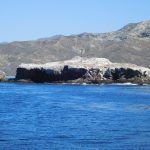 The Southwest side of Santa Cruz Island is much more rugged and has some awesome diving but it is also dictated by the weather. The weather on the southwest side comes mainly from the north along the outer edge of San Miguel and Santa Rosa. Because of this, it can be quite rough with high winds and seas.
The Southwest side of Santa Cruz Island is much more rugged and has some awesome diving but it is also dictated by the weather. The weather on the southwest side comes mainly from the north along the outer edge of San Miguel and Santa Rosa. Because of this, it can be quite rough with high winds and seas.
Of course, on a good day, you can get some excellent diving in at some of the sites around the southwest end making you want 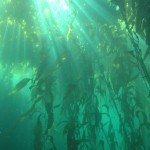 to go back for more. If the weather is calm there are some deeper outer pinnacles along with some excellent scallop hunting (due to the currents) between Santa Rosa and Santa Cruz islands. From the west end, it is a short distance to Gull Island on the backside and Painted Cave (one of the largest sea caves in the world) on the front west end of the island.
to go back for more. If the weather is calm there are some deeper outer pinnacles along with some excellent scallop hunting (due to the currents) between Santa Rosa and Santa Cruz islands. From the west end, it is a short distance to Gull Island on the backside and Painted Cave (one of the largest sea caves in the world) on the front west end of the island.
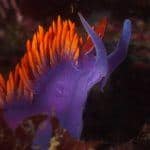 Not far from Gull Island you can find a WWII Navy Grumman Guardian Plane wreck. It sits on a sandy bottom creating its own reef. There is also Gull Island which is a Marine Protected area (MPA). It is one of the few spots in California that you can see purple hydro coral at shallow depths (15’-40’). The west end dive sites have something for everyone and are good for the photographer, sightseer, or hunter. One thing is for sure, the further west you get on Santa Cruz, the better the diving can get if the weather cooperates.
Not far from Gull Island you can find a WWII Navy Grumman Guardian Plane wreck. It sits on a sandy bottom creating its own reef. There is also Gull Island which is a Marine Protected area (MPA). It is one of the few spots in California that you can see purple hydro coral at shallow depths (15’-40’). The west end dive sites have something for everyone and are good for the photographer, sightseer, or hunter. One thing is for sure, the further west you get on Santa Cruz, the better the diving can get if the weather cooperates.
There are some good dive sites around this area with some of them listed below:
- The WWII Navy Grumman Guardian AF-2W-located in Laguna Harbor. This plane was on a mission in March of 1954 searching for a missing jet. It had engine trouble and was ditched in the water with no problems. It is outside of a harbor near Gull Island, Santa Cruz Island at a depth of 50’-60’. The plane sits upright on a sandy bottom and has become an artificial reef with kelp and fish around it and the visibility is from 10’-30’. This can be a very fun dive if the weather is on our side.
- Gull Island- Located on the southwest side (backside) of Santa Cruz Island. It is a small rock island a little over 1 mile offshore and is in a Marine Protected Area. Gull Island has excellent diving all around it with depths ranging from 20’-110’ and visibility from 20’-80’. The diving around Gull Island is rocky reefs with kelp, fish, lobsters, sea lions, and lots of invertebrates and small clumps of purple hydrocoral. There are also some outer deep walls close by which make for some exciting diving. You could easily spend most of a day diving here and not see the same thing twice plus the Guardian plane wreck is not far away.
- Morse Point-This site has small rocky pinnacles with finger reefs extending outward with lots of kelp, rockfish, kelp bass, sheepshead, some lobsters, and lots of invertebrates. Photography and hunting can both be good here in depths from 40’ to 75’.
- Fraser Cove- West Point, Fraser Cove, and Forney’s Cove have some excellent reef structure with lush kelp, fish, and other marine life and depths of about 20’-60’ deep.
- Forney’s Cove-This area is a large anchorage with a rocky reef sloping down to a sandy bottom. You can find scallops, calico bass, and sheepshead among the rocks here plus an occasional halibut in the sand. Depths here are 20’-50’ deep. Photography can also be good with all the invertebrate life you will find on the rocks. There is also an area where the water boils around some wash rocks not far from Forney’s Cove known as the “Potato Patch”.
Northwest Santa Cruz Island-West Point to Fry’s Harbor
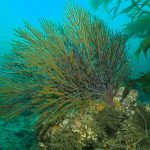 The north side of Santa Cruz can be equally as nice as the backside and there are some small harbors with anchorages that offer protection for boats. Some of these are Hazards, Lady’s, Diablo, and Fry’s. On days when the weather is in your favor, the ocean can be calm and calling your name for some excellent diving.
The north side of Santa Cruz can be equally as nice as the backside and there are some small harbors with anchorages that offer protection for boats. Some of these are Hazards, Lady’s, Diablo, and Fry’s. On days when the weather is in your favor, the ocean can be calm and calling your name for some excellent diving.
The Northwest side of Santa Cruz is rugged with steep cliffs, caves, and lots of crevices. This is where the Painted Cave is located. Painted Cave is the second-longest and one of the deepest sea caves in the  world and is large enough to pilot most any dive boat into it. There is no diving inside Painted Cave because the walls are barren. It could also be hazardous due to boat traffic from people trying to see the inside. There are some great dive sites along this side of Santa Cruz Island with many of them up alongside the island where the steep cliffs drop off to underwater walls. There are also some good pinnacles, large exposed rocks, and seamounts offshore to explore for the advanced diver when currents allow. Depths can vary from 30’-110’ and visibility can be 20’-50’.
world and is large enough to pilot most any dive boat into it. There is no diving inside Painted Cave because the walls are barren. It could also be hazardous due to boat traffic from people trying to see the inside. There are some great dive sites along this side of Santa Cruz Island with many of them up alongside the island where the steep cliffs drop off to underwater walls. There are also some good pinnacles, large exposed rocks, and seamounts offshore to explore for the advanced diver when currents allow. Depths can vary from 30’-110’ and visibility can be 20’-50’.
There are some good dive sites around this area with some of them listed below:
- Del Mar Caves-Another site along Santa Cruz Island with some caves that are best to stay out of without proper training. Where there are caves there are lots of rocks and crevice to explore and this site has all that. Large rocks in a cove that are spread out leading to a sandy bottom. Kelp growing in the shallows and mini walls along the rocks. Great spot for photography. One cool thing to look for is the simnia snails that live on the stalks of the red gorgonians. Depths from 15’-60’
- Ruby Rock-Ruby Rock is located in a cove that usually has calm conditions with the rock to the east end. It sits out from the main island and has a large channel running between with a wall on both sides. The cove actually has a couple of other walls with all going to depths of 50’-90’ plus. The walls lead down to a sandy bottom where you can find some very cool tube anemones and nudibranchs. Many Santa Cruz dive sites in this area have caves and this site is no different from one close to the center of the cove. The walls have lots of invertebrates, some rockfish, and gorgonians and are much better for photography.
- Painted Cave-No diving in Painted Cave due to boat traffic but VERY cool to see inside while on a boat if weather permits. The walls to the east and west of the cave are sheer walls with lots of invertebrates, some fish, and some kelp. Best to pick other sites due to weather and boat traffic!
- Diablo Pinnacle– is offshore from Diablo Point and is a large offshore underwater mound. It is more like a rocky reef that tops out at around 50’ with depths around the bottom at 120’. Can be good for spearfishing for lingcod and rockfish. Also, good for photography with lots of invertebrates and gorgonians.
Northeast Santa Cruz Island-Fry’s Harbor to San Pedro Point
 This area has a number of good anchorages such as Platt’s, Prisoners, and Chinese Harbors. Platt’s Harbor has some bald eagles that nest in the trees above so keep a watchful eye out. The Northeast side of Santa Cruz Island includes some of the more well-known dive sites such as Coche Point, Potato Rock, Scorpion’s Anchorage, and the wreck of the Spirit of America, also known as the Peacock.
This area has a number of good anchorages such as Platt’s, Prisoners, and Chinese Harbors. Platt’s Harbor has some bald eagles that nest in the trees above so keep a watchful eye out. The Northeast side of Santa Cruz Island includes some of the more well-known dive sites such as Coche Point, Potato Rock, Scorpion’s Anchorage, and the wreck of the Spirit of America, also known as the Peacock.
 Many of the dive sites in this area are up against the island, on pinnacles and large rocks such as Potato Rock and Scorpion Rock or protected coves. These sites can be good for hunting and photography with depths of 20’-100’ and visibility from 15’-50’. Some of these areas can be good for spearfishing, scallops collecting, photography, and the occasional sighting of sea lions and harbor seals.
Many of the dive sites in this area are up against the island, on pinnacles and large rocks such as Potato Rock and Scorpion Rock or protected coves. These sites can be good for hunting and photography with depths of 20’-100’ and visibility from 15’-50’. Some of these areas can be good for spearfishing, scallops collecting, photography, and the occasional sighting of sea lions and harbor seals.
If hiking and camping is your thing, Scorpion Harbor is where the Island Packers Company drops off people for day use, hiking, and camping and this area is also in a Marine Reserve (MA).
There are some good dive sites around this area with some of them listed below:
- Scorpion’s Rock-Scorpion’s Rock is a large rock to the west of Scorpion’s Anchorage and the east side of the rock is a great dive. The middle part is a slight slope to the sand and the ends along the sides of the rock have small walls. There is lots of crevices and rocky reef wandering down to a sandy bottom. Lots of kelp, gorgonians, invertebrates, fair amount of fish and it is within the Scorpion Marine Reserve. Depths are from 20’-50’.
- The wreck of the Spirit of America-formerly identified as the Peacock, the Spirit of America had a lot of mystery around her. It was known that the wreck was a WWII Minesweeper that sunk in the 70s. The Spirit of America sits upright on a sandy bottom at about 65’ deep outside the Scorpion Anchorage, Santa Cruz Island. Visibility here can be 15’-40’. With the hull and its structure to explore the Spirit of America is a very good dive. It is in a protected area and there are lots of fish and the biggest Spanish Shawls on her.
- Adams Cave-Large rocks alongside the island creating swim-throughs and large crevices. Lots of kelp, some good size fish, and lots of invertebrate life. Depths are between 20’-50’.
- San Pedro Point area: This area is very rugged and rocky with steep walls, lots of crevices, and kelp. When the weather is Extremely calm with no swell, current, or surge the diving can be excellent for hunting scallops, fish, and lobsters with depths between 30’-60’. Photography or sightseeing can also be very good with lots of invertebrate life.
Santa Rosa Island
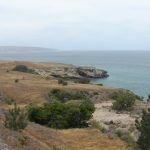 Santa Rosa is the second-largest island. Nearly 15 miles long and 10 miles wide, its 84 square miles exhibit remarkable contrasts. Cliffs on the northeastern shore rival those of Santa Cruz Island. High mountains with deeply cut canyons give way to gently rolling hills and flat marine terraces. Rocky terraces on the west end provide habitat for intertidal organisms. Harbor and elephant seals breed on the island’s sandy beaches. The
Santa Rosa is the second-largest island. Nearly 15 miles long and 10 miles wide, its 84 square miles exhibit remarkable contrasts. Cliffs on the northeastern shore rival those of Santa Cruz Island. High mountains with deeply cut canyons give way to gently rolling hills and flat marine terraces. Rocky terraces on the west end provide habitat for intertidal organisms. Harbor and elephant seals breed on the island’s sandy beaches. The 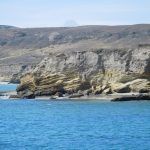 entire island is surrounded by expanses of kelp beds. Consequently, its surrounding waters serve as an invaluable nursery for the sea life that feeds larger marine mammals and the sea birds that breed along the coastal shores and offshore rocks of all the Channel Islands.
entire island is surrounded by expanses of kelp beds. Consequently, its surrounding waters serve as an invaluable nursery for the sea life that feeds larger marine mammals and the sea birds that breed along the coastal shores and offshore rocks of all the Channel Islands.
Diving Santa Rosa Island
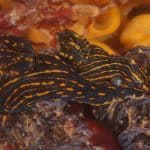 Scuba diving at Santa Rosa Island can be quite interesting and fun with a variety of marine life both below the water and above. Because of its location, it seems to get overlooked by boats going to San Miguel or Santa Cruz Islands. It can also be hard to get to due to weather so always have a backup plan. Because of this the dive sites having less pressure from divers which can make them quite good for the hunter or photographer.
Scuba diving at Santa Rosa Island can be quite interesting and fun with a variety of marine life both below the water and above. Because of its location, it seems to get overlooked by boats going to San Miguel or Santa Cruz Islands. It can also be hard to get to due to weather so always have a backup plan. Because of this the dive sites having less pressure from divers which can make them quite good for the hunter or photographer.
What to Expect
There are many of the same things that you would normally see at San Miguel Island such as large schools of rockfish, huge sunflower stars, a colorful array of anemones, scallops, and an abundance of invertebrates, wolf eels, large lobsters, and 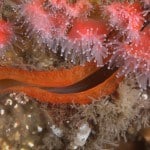 lingcod.
lingcod.
 Santa Rosa is also home to a number of wrecks such as the Aggi, Golden Horn, SS Chicksaw, and the Crown of England plus it also has its Marine Protected Areas (MPA) where it is strictly, look and don’t touch.
Santa Rosa is also home to a number of wrecks such as the Aggi, Golden Horn, SS Chicksaw, and the Crown of England plus it also has its Marine Protected Areas (MPA) where it is strictly, look and don’t touch.
Because Santa Rosa Island is quite large we will cover it here in two sections and call them the Northside (front side)-Sandy Point to East Point and the Southside (backside)-East Point to Sandy Point.
Northside (front side)-Sandy Point to East Point
Starting at the west end is probably one of the best-known areas, Talcott Shoals which is known for its good lobster diving. Close to Talcott Shoals is the wreck of the Aggi which was a three-masted barkentine ship that sunk in early May 1915. Moving east you come to Brockway Point and then to Carrington Point which is a Marine Reserve (MR). Both have large shallow reefs and just past Carrington Point, you have Becher’s Bay. Becher’s Bay provides good protection from the weather with its Northeast and Southeast anchorages. At the east end of Santa Rosa Island, you have Skunk Point and East Point with most of the area between the two designated the Skunk Point Marine Reserve (MR).
Listed are a few of the great dive sites along the Northside area of Santa Rosa:
- Aggi Wreck- The Aggi was a three-masted sailing ship that was 265-feet long, and almost 40-feet wide. She originally was named the Aspice and through the years and many changes became the Aggi. She was being towed in a bad storm and because of the rough seas, they had to release her tow. She drifted and on May 4, 1915, she was washed onto Santa Rosa Island. The majority of the wreckage lies in 20 to 30 feet of water in the Talcott shoal’s area, with some debris reaching depths of 50′. She can be a fun dive when the weather permits.
- Talcott Shoals-Very large area that is known for some good lobster diving. Some fish like sheepsheads and lingcod and some small rockfish. Lots of invertebrate life in the deeper waters and good for macro photography. This area has lots of ledges and diagonal reef structures with lots of smaller holes for lobsters to hide in. The ledges for the most part run parallel to each other with other rock debris and sand between them. Some kelp in the shallow areas. This area is very weather-dependent with depths of 20’-80’ plus.
- Rhodes Reef-This is an offshore pinnacle that breaks the surface and diving it is very weather dependent. It slopes to a rocky reef with some kelp. Good spearfishing area for rockfish and kelp bass and great for photography with lots of invertebrates, large anemones, and sea stars. Depths from 20’-60’.
- Carrington Point-Very large rocky reef with some kelp. Good spearfishing area for rockfish and kelp bass and great for photography with lots of invertebrates, large anemones, and sea stars. Depths from 20’-60’.
Southside (backside)-East Point to Sandy Point
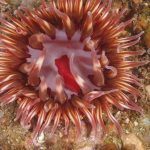 On the southside, there are many good dive spots especially when it is calm enough to dive along the west end between Sandy Point and South Point. Here you will find the wrecks of the Golden Horn, a four-masted bark carrying coal that sunk in September 1892, and the Chickasaw. Besides the wrecks, there are some other good sites in this area. They are Bee Rock, Cluster Point, and South Point with the area between Cluster Point and South Point being designated the South Point Marine Reserve (MR).
On the southside, there are many good dive spots especially when it is calm enough to dive along the west end between Sandy Point and South Point. Here you will find the wrecks of the Golden Horn, a four-masted bark carrying coal that sunk in September 1892, and the Chickasaw. Besides the wrecks, there are some other good sites in this area. They are Bee Rock, Cluster Point, and South Point with the area between Cluster Point and South Point being designated the South Point Marine Reserve (MR).
The east side is protected 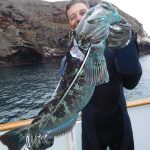 by South Point and therefore usually has the best diving conditions. It is here you will find the Johnson Lee anchorage used by charter boats out on multi-day trips. Other good dive sites along the east end are Ford Point and the East End pinnacles and the Crown of England wreck. The Crown of England was a steamship that ran aground in November 1894. Because of fog and navigating around the islands could be harsh, quite a few of the ships meet their fate by running aground. Because of the weather around the northern islands, Santa Rosa is where you may end up if going to San Miguel and you will not be sorry that you did.
by South Point and therefore usually has the best diving conditions. It is here you will find the Johnson Lee anchorage used by charter boats out on multi-day trips. Other good dive sites along the east end are Ford Point and the East End pinnacles and the Crown of England wreck. The Crown of England was a steamship that ran aground in November 1894. Because of fog and navigating around the islands could be harsh, quite a few of the ships meet their fate by running aground. Because of the weather around the northern islands, Santa Rosa is where you may end up if going to San Miguel and you will not be sorry that you did.
Listed are a few of the great dive sites along the Southside of Santa Rosa Island:
- East End Pinnacles-This area consists of several pinnacles that are more like large sea mounds with flat tops on them. There are some large walls along the sides and lots of crevices throughout the area. You will find some kelp, fish, and lobsters but the best is the excellent macro photography you will find here with all the invertebrate life that covers the pinnacles. The tops of the pinnacles are about 40’-50’ deep and the surrounding area gets to about 90’.
- Ford Point-Very large rocky area with lots of structure and lots of healthy kelp. You can find sheepshead, lingcod, lobsters, rockfish, and kelp bass along with a number of abalones. Good photography with lots of invertebrates, large anemones, and sea stars. Depths between 30’-70’.
- Johnsons Lee-An excellent anchorage for boats needing a safe place to spend the night. Mostly rocky reef with nice structure and sand channels between reef sections. Quite a bit of kelp with invertebrate life and smaller fish making it not the best for hunting game. Depths between 25’-50’.
- The Chickasaw Wreck-Built in 1942 as a cargo ship, she was later refitted, renamed, and served as a WW II auxiliary transport ship. After the war, she was returned to civilian duty and renamed again as the Chickasaw which ran aground in February 1962 carrying cargo from Japan. Most all of her has been returned to the ocean disintegrating into the surf line. Nothing remains visible of the ship now and few have dived her. The area is a rocky reef, lots of kelp, and shallow. There are large sheepshead and spearfishing can be good here on calm days. Depths from 10’-40’. More information.
- Bee Rock-Two exposed rock creating an excellent dive site when weather permits which isn’t often making this an untouched site. Steep sides leading to large rocks and crevices with healthy kelp, rockfish, kelp bass, sheepshead, and more. Good for spearfishing and excellent for photography with lots of invertebrates, sea stars, anemones, and more. Depths of 20’-70’.
San Miguel Island
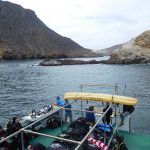 San Miguel is about eight miles long and four miles wide. It is primarily a plateau about 500 feet in elevation with two tall hills that emerge from its wild, windswept landscape. One of the most spectacular wildlife displays in the park is viewing the thousands of seals and sea lions that breed on its isolated shores.
San Miguel is about eight miles long and four miles wide. It is primarily a plateau about 500 feet in elevation with two tall hills that emerge from its wild, windswept landscape. One of the most spectacular wildlife displays in the park is viewing the thousands of seals and sea lions that breed on its isolated shores.
Fifty-five miles off the coast from Ventura, San Miguel Island is the farthest west of the Channel Islands. Because of its location in the  open ocean, it is subject to high winds, swell and nasty weather that comes straight down from the north. It has 27 miles of jagged, rocky coastline dotted with sandy white beaches, and the westernmost of these beaches, Point Bennett, is the only place in the world where up to six different species of pinnipeds can be found including elephant seals, sea lions, and harbor seals. Along with the pinnipeds come sharks looking for food so always be cautious when in the water close to the Point Bennet area.
open ocean, it is subject to high winds, swell and nasty weather that comes straight down from the north. It has 27 miles of jagged, rocky coastline dotted with sandy white beaches, and the westernmost of these beaches, Point Bennett, is the only place in the world where up to six different species of pinnipeds can be found including elephant seals, sea lions, and harbor seals. Along with the pinnipeds come sharks looking for food so always be cautious when in the water close to the Point Bennet area.
Diving San Miguel Island
 Scuba diving at San Miguel Island can be an excellent adventure when you make it there. Between the wind and swell it can be a 50-50 proposition. San Miguel is influenced by the cooler, nutrient-rich California current which results in cool water temperatures (48°-55° F.) and marine life typical to what you would expect to find along the central California coastline.
Scuba diving at San Miguel Island can be an excellent adventure when you make it there. Between the wind and swell it can be a 50-50 proposition. San Miguel is influenced by the cooler, nutrient-rich California current which results in cool water temperatures (48°-55° F.) and marine life typical to what you would expect to find along the central California coastline.
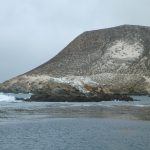 In good weather, usually in the fall, diving is great, with spectacular visibility. San Miguel offers many excellent dive sites for the hunter, photographer, or sightseer. San Miguel is also home to some of the best pinnacles and dive sites you will ever dive. two of them are Wilson’s Rock which is two miles off the northwest side of San Miguel and Richardson’s Rock which is eight miles northwest of San Miguel. On rare occasions when you can make it to either of these sites you are in for a treat. San Miguel is host to many great dive sites like Wyckoff Ledge, Skyscraper, Castle Rock, Prince Island, CIDA Reef, and more.
In good weather, usually in the fall, diving is great, with spectacular visibility. San Miguel offers many excellent dive sites for the hunter, photographer, or sightseer. San Miguel is also home to some of the best pinnacles and dive sites you will ever dive. two of them are Wilson’s Rock which is two miles off the northwest side of San Miguel and Richardson’s Rock which is eight miles northwest of San Miguel. On rare occasions when you can make it to either of these sites you are in for a treat. San Miguel is host to many great dive sites like Wyckoff Ledge, Skyscraper, Castle Rock, Prince Island, CIDA Reef, and more.
What to Expect
You can never go wrong diving San Miguel with its diversity and abundance of marine life. Some of the things you can see are wolf eels, large lingcod, large schools of rockfish, huge sunflower stars, a colorful array of anemones, scallops, and a general abundance of invertebrates and some are only found north of Point Conception.
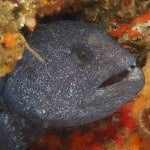 San Miguel also has had her fair share of stranded vessels on her shores over the years and the most notable one is the wreck of the Cuba at Point Bennett. The Cuba was a Steam Powered Passenger Vessel and ran aground in September 1923. San Miguel also has its Marine Protected Areas (MPA) where it is strictly, look and don’t touch. The biggest is on the Northside of the island and is the Harris Point Marine Reserve (MR) and includes
San Miguel also has had her fair share of stranded vessels on her shores over the years and the most notable one is the wreck of the Cuba at Point Bennett. The Cuba was a Steam Powered Passenger Vessel and ran aground in September 1923. San Miguel also has its Marine Protected Areas (MPA) where it is strictly, look and don’t touch. The biggest is on the Northside of the island and is the Harris Point Marine Reserve (MR) and includes 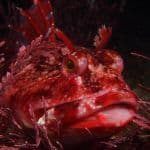 almost all the area between Simonton Cove and Bay point. This area includes Prince Island and most of Cuyler Harbor.
almost all the area between Simonton Cove and Bay point. This area includes Prince Island and most of Cuyler Harbor.
There are two other Marine Protected Areas (MPA) and they are the Richardson Rock Marine Reserve (MR) that is offshore from the island and the Judith Rock Marine Reserve (MR) that is on the southwest side of the island.
*Here is a short story written by Ken Kollwitz on why it can be so hard to dive San Miguel Island.
Because of the size of San Miguel along with its outer pinnacles and rocks, we will cover San Miguel Island in three sections and call them the Outer Pinnacles, Northside (front side) from Point Bennet to Cardwell Point and the Southside (backside) from Cardwell Point to Point Bennett as our reference.
Listed are a few of the great dive sites around San Miguel Island:
Outer Pinnacles:
- Wilson’s Rock-This is a large exposed pinnacle/seamount about two miles off the northwest side of San Miguel Island. It is more like a series of pinnacles with steep walls, large crevices, and valleys and is an awesome dive when weather permits. All the San Miguel offshore pinnacles are some of the best diving you will find in California! You will find tons of invertebrate life here, octopus, large lingcod and vermillion rockfish, wolf eels, and more. Excellent for the photographer, hunter, and sightseer. Depths are between 30’-130’ plus.
- Richardson’s Rock-Another large exposed pinnacle/ seamount about eight miles off the northwest side of San Miguel Island. Again, it is more like a series of pinnacles with steep walls, large crevices, and valleys and is an awesome dive when weather permits. You will find tons of invertebrate life here, octopus, large lingcod and vermillion rockfish, wolf eels, and more. Excellent for the photographer and sightseer. Depths are between 20’-130’ plus and t is in the Richardson Rock Marine Reserve (MR) so no hunting here, only photos and memories of an awesome dive!
- Boomerang- This is a large pinnacle/ seamount located six miles north of Point Bennett, San Miguel Island. Like the other pinnacle/seamounts it too has steep walls and large crevices covered with all types of invertebrates. It also has a healthy population of fish such as vermillion, lingcod, rockfish, and more. Wolf eels can also be found here. Depths are between 60’-130’.
- Skyscraper-Another large pinnacle/ seamount located not far from Wilson’s Rock and much like Boomerang. There are some caves going into the rock here at deeper depths so be careful if exploring them. Depths are between 60’-130’.
Northside (front side) from Point Bennet to Cardwell Point:
- CIDA Reef-This reef is in the foul area and is located in the northwest end of San Miguel Island. This area is called the foul area on maps for a GOOD reason so beware when diving it if weather permits. If weather permits this can be some of the BEST diving off San Miguel Island. This is a large rocky area with large crevices, some mini walls, lots of jagged rock all very dramatic looking with kelp growing all around it. Because of its location, you will find everything you could ever want to see here-TONS of invertebrates, large fish, wolf eels, octopus, and much more. Depths are between 30’-70’
- Simonton Cove-A very large sandy area and sparse with rocky reefs. Can be a great spot for hunting large halibut but not much else. Depths are between 25’-50’. If planning to hunt parts of Cuyler Harbor are in the Harris Point Marine Reserve (MR) area so know exactly where you are first.
- Cuyler Harbor-Nice shallow rocky reef area with sand between reefs. Healthy kelp growing and lots of invertebrate life here to keep the photographer happy. Some fish but better for sightseeing and photographers. Depths are between 25’-50’. If planning to hunt parts of Cuyler Harbor are in the Harris Point Marine Reserve (MR) area so know exactly where you are first.
- Prince Island-The Island can be an excellent dive site giving shelter when the weather is not its best. The entire area is a rocky reef with lots of rocks and good structure. You can dive the sloped sides of the island or go out deeper where it levels off. Lots of healthy kelp and invertebrate life on the reef. Some large fish such as lingcod, rockfish, and kelp bass but this area is a no-take zone and in the Harris Point Marine Reserve (MR). Good area for photography and sightseeing. Depths are between 15’-50’.
Southside (backside) from Cardwell Point to Point Bennett:
- Wyckoff Ledge-This is one of those must-do San Miguel dive sites and can be somewhat sheltered when the weather isn’t the best. The large rocky area with lots of healthy kelp. Shallow reef with walls dropping off the side to large boulders in the sand. Lots of very large crevices, jagged rocks, and ledges on the wall make this a very exciting dive. Tons of invertebrate life everywhere, large lingcod’s resting on the ledges, sheepshead and rockfish along with kelp bass, octopus, wolf eels, and much more. Easy to make several dives here and not see the same things. Depths are between 20’-80’.
- Tyler Bight-This spot is another favorite and covers quite a large area. It is a short distance to the east of Wyckoff Ledge and is just as dramatic without the walls. All the same marine life here with lots of abalones and some excellent spearfishing for large lingcods and vermillion. Excellent macro photography with all types of invertebrates here and this site is a gradual slope to the sandy bottom. Depths are between 20’-60’.
- Judith Rock-This site is in the Judith Rock Marine Reserve (MR) and another excellent dive site that doesn’t get as much attention as some of the other sites. It is a large submerged rock that has a small top and stair steps down to deeper depths with lots of crevices, ledges, and valleys to explore. Very healthy kelp, large fish of all types, and tons of invertebrates. One dive here is not enough. Depths from about 50’-100’ plus.
- Adams Cove-Nice rocky reef area with lots of large rocks, kelp, fish, and invertebrate life. Very close to a sea lion haul out on the island and if the boat you are on will get close you can have some excellent marine mammal viewing there. Depths are between 30’-60’.
